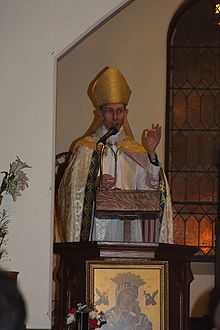Bernard Tissier de Mallerais

| Ordination history of Bernard Tissier de Mallerais | |
|---|---|
Episcopal consecration | |
| Principal consecrator | Marcel Lefebvre |
| Co-consecrator | Antônio de Castro Mayer |
| Date of consecration | 30 June 1988 |
| Place of consecration | The International Seminary of Saint Pius X, Écône, Switzerland |
Bishops consecrated by Bernard Tissier de Mallerais as principal consecrator | |
| Licínio Rangel | July 28, 1991 |
Bernard Tissier de Mallerais, SSPX (born 14 September 1945) is a bishop of the Society of St. Pius X.
Pope John Paul II issued Tissier an automatic excommunication latae sententiae after he received Archbishop Marcel Lefebvre's unauthorized consecration on 30 June 1988, deemed by the Holy See to be "unlawful" and "a schismatic act",[1] Pope Benedict XVI remitted the excommunication on 21 January 2009.
Early life and ministry
Tissier de Mallerais was born in Sallanches, Haute-Savoie, France. After obtaining a university degree in biology, he entered the International Seminary of Saint Pius X at Fribourg in October 1969. On June 29, 1975 he was ordained priest by Archbishop Marcel Lefebvre at Écône. He served first as a professor, then as vice-rector, and finally as rector of the seminary at Écône. Then he was appointed Secretary General of the SSPX.
Consecration and excommunication
In June 1988 Archbishop Marcel Lefebvre announced his intention to consecrate Tissier de Mallerais and three other priests as bishops. Lefebvre did not have a pontifical mandate for these consecrations (i.e. permission from the pope), normally required by Canon 1382 of the Code of Canon Law. On 17 June 1988 Cardinal Bernardin Gantin, prefect of the Congregation for Bishops sent Tissier de Mallerais a formal canonical warning that he would automatically incur the penalty of excommunication if he were ordained by Lefebvre without papal permission.
On 30 June 1988 Tissier de Mallerais and the three other priests were consecrated bishop by Archbishop Lefebvre. On 1 July 1988 Cardinal Gantin issued a declaration stating that Lefebvre, Tissier de Mallerais, and the three other newly-ordained bishops "have incurred ipso facto the excommunication latae sententiae reserved to the Apostolic See".
On 2 July 1988, Pope John Paul II issued the motu proprio Ecclesia Dei, in which he reaffirmed the excommunication, and described the consecration as an act of "disobedience to the Roman pontiff in a very grave matter and of supreme importance for the unity of the Church", and that "such disobedience — which implies in practice the rejection of the Roman primacy — constitutes a schismatic act".[2] Cardinal Darío Castrillón Hoyos, head of the commission responsible for implementing Ecclesia Dei, has said this resulted in a "situation of separation, even if it was not a formal schism".[3]
Tissier de Mallerais and his supporters denied the validity of the excommunication, saying that the consecrations were necessary due to a moral and theological crisis in the Catholic Church.[4][5][6]
SSPX bishop

After his episcopal consecration, Tissier de Mallerais continued in his position of Secretary General of the SSPX until 1996. In 1991, he consecrated Licínio Rangel as bishop for the Priestly Society of St. John Mary Vianney after the death of its founder, bishop Antônio de Castro Mayer.
In 1996, he was charged with writing a biography of Archbishop Marcel Lefebvre; the work was published in 2002.
In that same year, the history professor Luc Perrin claimed that he "went as far as to consider the present Roman Catholic Church is not a Christian Church, casting serious doubts on the validity of the 'conciliar' priesthood, calling it a 'gnostic priesthood' (Homily of June 27, 2002)."[7]
By a decree of 21 January 2009 (Protocol Number 126/2009), which was issued in response to a renewed request that Bishop Fellay made on behalf of all four bishops whom Lefebvre had consecrated on 30 June 1988, the Prefect of the Congregation for Bishops, by the power expressly granted to him by Pope Benedict XVI, remitted the alleged automatic excommunication that they had thereby incurred, and expressed the wish that this would be followed speedily by full communion of the whole of the Society of Saint Pius X with the Church, thus bearing witness, by the proof of visible unity, to true loyalty and true recognition of the Pope's Magisterium and authority.[8]
The canonical situation of three of the four bishops thus became the same as that of the other clergy of the Society, who are suspended a divinis.[9] Bernard Tissier de Mallerais was never suspended a divinis, because he was ordained priest on June 29, 1975. The punishment of the Holy See hits priests ordained by Archbishop Marcel Lefebvre since July 1976 and a a divinis can never be retroactive.
Works
Bernard Tissier de Mallerais in libraries (WorldCat catalog)
References
- ↑ Apostolic Letter 'Ecclesia Dei'.
- ↑ Apostolic letter Ecclesia Dei (2 July 1988). Vatican.va. Accessed 2008-01-01.
- ↑ Interview for 30 days (2005). 30giorni. Accessed 2008-01-01.
- ↑ SSPX FAQ Question 11 (29 June 1987). SSPX.org. Accessed 2008-01-01.
- ↑ The 1988 consecrations: a theological study (July & September 1999). Sì sì no no via SSPX.org. Accessed 2008-01-01.
- ↑ The 1988 consecrations: a canonical study (November 1999). Sì sì no no via SSPX.org. Accessed 2008-01-01.
- ↑ Luc Perrin, professor at the University of Strasbourg 2 - Marc Bloch, where he teaches History of the Church, in a 2 September 2006 interview A Historian observes the Catholic moment
- ↑ Remissione Della Scomunica Latae Sententiae Ai Vescovi Della Fratertinà Sacerdotale San Pio X, 24.01.2009
- ↑ Letter of the Pontifical Commission Ecclesia Dei of 29 September 1995)
|